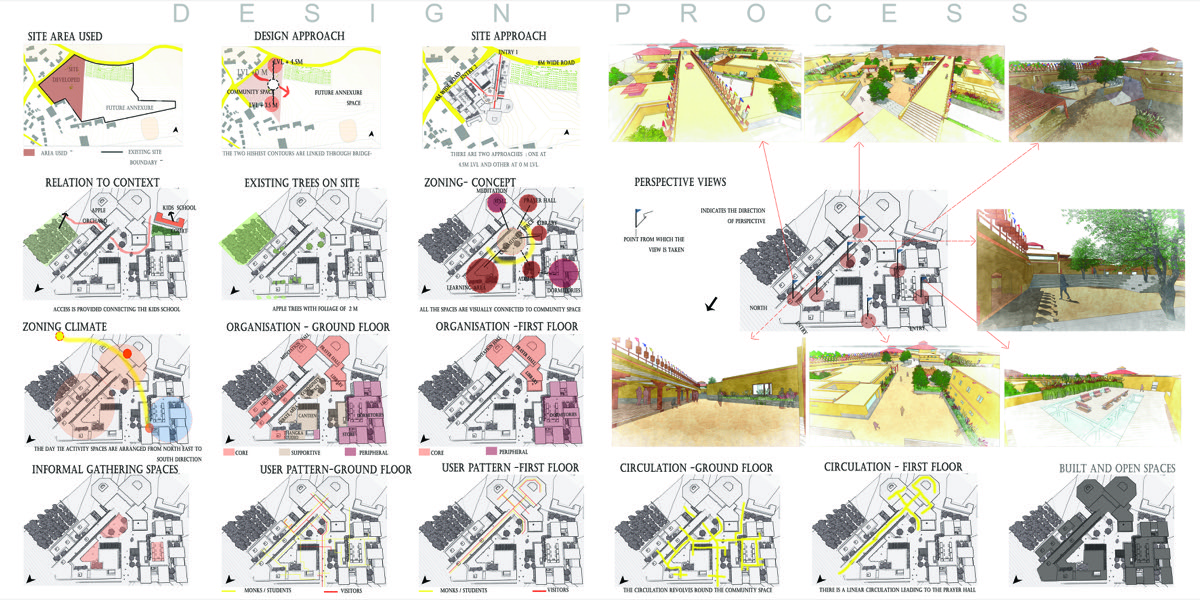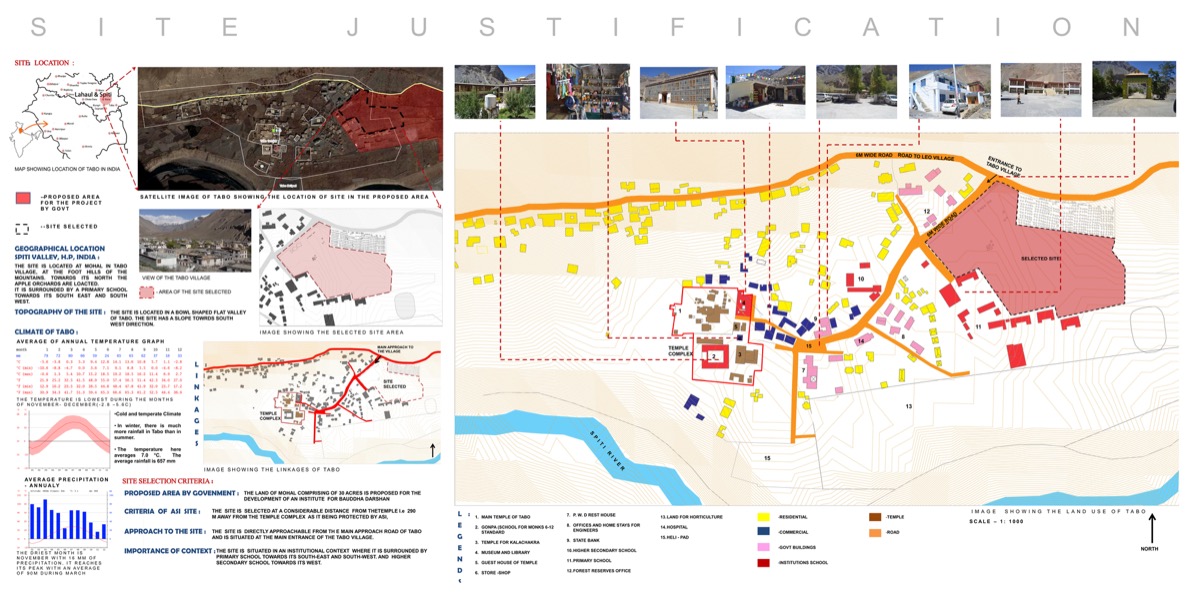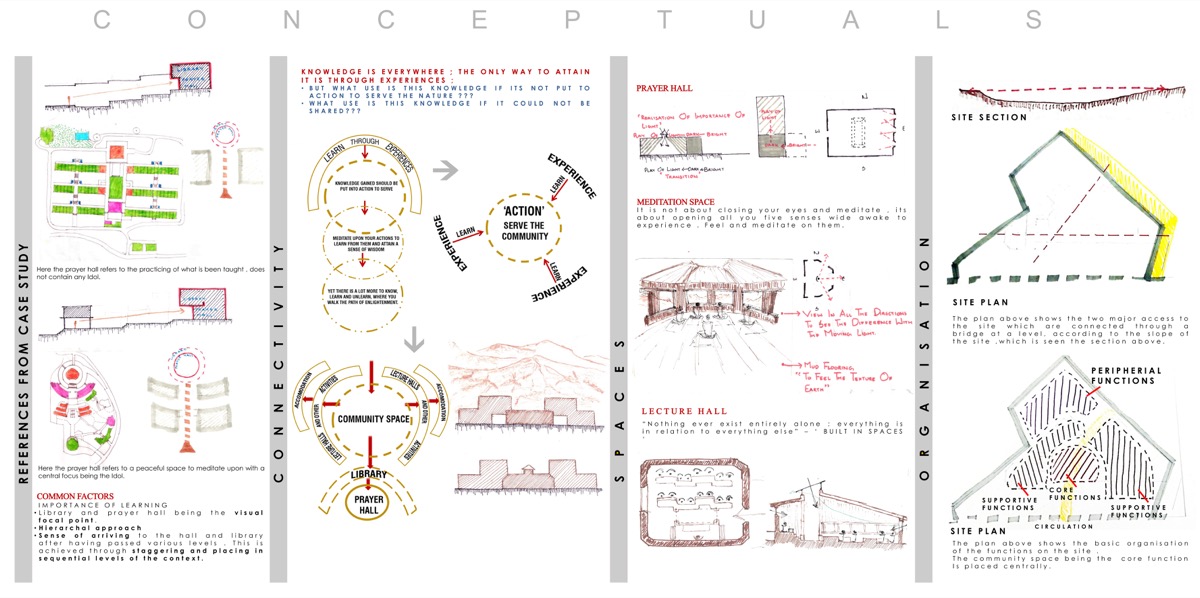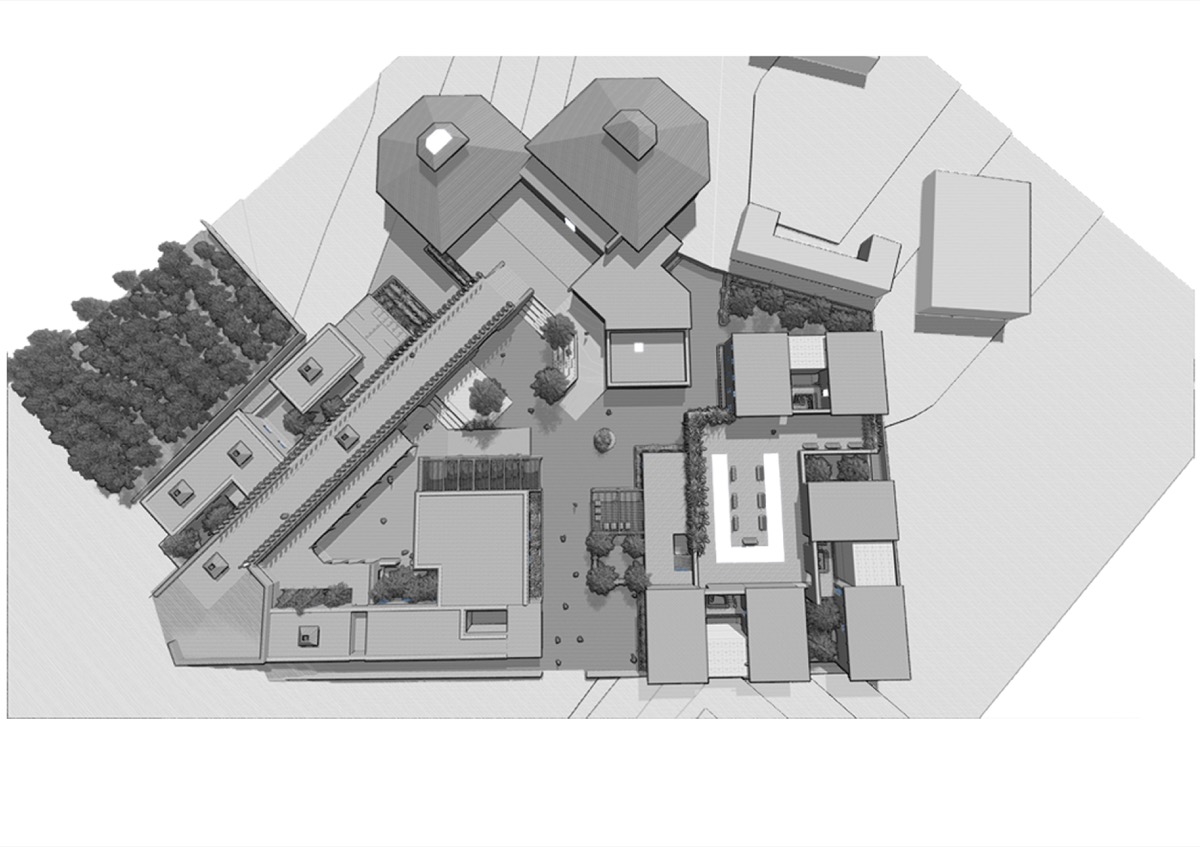ABSTRACT
The idea of designing a Bauddha Darshan Centre at Tabo is due to the historical significance of the region as a major learning hub and preserver of many manuscripts of Buddhism.
With this proposal, the opportunities for perceiving higher studies in Buddhism, not only for the monks and locals but also for other foreign people can be generated which further leads to the development of the locals as well as the town by exchange of ideas and methods through this centre.
An effort is made to promote the importance of local architecture language within the people of Tabo through the use of vernacular materials in order to reflect the local values.

AIM :
To preserve the local traditions and historic value of Tabo monastery and support the existing cultural values by creating an architectural module for the town that utilises both the modern as well as traditional understandings.
VISION :
To enrich the village of Tabo by developing it as a centre where people not only learn and conduct historic Buddhist research but also become a part of the village where exchange of ideas takes place.
OBJECTIVES:
- Preserve the Traditional Buddhist legacy by providing opportunities to study further.
- Promote local economy through their own traditions and craft.
- Generate awareness of traditional building know how by creating a module and aspire people to build with their traditional sense and preserve their ecology.
SCOPE :
Tabo being 1000years old and hosting no.of manuscripts will encourage no.of people for further studies and also create opportunities for locals, if provided with better facilities.
By setting up an example of a built module reflecting their own traditions and culture in terms of spaces and materials, will help people understand the socio-culture of that place.
BAUDDHA DARSHAN CENTRE
The Centre functions as a place where Higher Education in Buddhist Philosophy (referring as Bauddh Darshan) is provided for the Buddhist Monks and also basic understanding of Buddhism, its literature and Languages are taught to lay people for a better understanding of the manuscripts.
WHY AN EDUCATIONAL INSTITUTE ALONG WITH MONASTERIES?
To preserve the most valuable Buddhist Arts, Culture and Language of Lahul, Spiti, Kinnaur, Pangi, Kullu and Manali of Himalayan state Himachal Pradesh
To provide traditional and modern education to the monks and nuns of the Gonpas.
MAIN AIM AND PURPOSES OF THESE INSTITUTES:
1) Taking universal responsibility and seeking lasting happiness through imparting the education of Buddhist View of Interdependent origination and non violence practice.
2) Learning modern subjects like economics, mathematics and English language etc. with traditional/cultural education to cope with the time and the society and to produce lots of educated person having combined knowledge of both traditional and modern education.
CONCEPT BRIEF:
The spaces are arranged according to the buddhist philosophy of gaining knowledge and its use.All the spaces revolve round the community space, reminding them of their act and sequence of spaces follow the hierarchy of
LEARNING (LEARNING SPACE)
↓
Putting To Action After Learning (COMMUNITY SPACE)
↓
Meditate Upon The Action To Attain A Sense Of Wisdom (MEDITATION HALL AND PRAYER HALL)
↓
Yet There’s a Lot More To Learn and Unlearn; Path Of Enlightenment (LIBRARY)
DESIGN BRIEF:
The site is approached from North and West which is 3M below the North Entrance.A pathway(which is the roof of the lecture halls) leading to the main temple, acting as a bridge; with the view of just the temple and mountains as an overpowering background is created. A continuous Ramp is created around the community space connecting the Learning Area i.e, 1M below the ground level, Community Space on ground level and the Pathway (The Roof). A ramp is also created within the prayer hall connecting the Ground and Upper Level. It revolves round the statue of Buddha forming the part of PRADAKSHINA act, where the prayer wheels act as railings.
Sheets:
(The design is explained through basic architectural plans and sections with its structural drawings, 3D views and exploded structural system, generated using only ArchiCAD software.)


















11 Responses
Hi Anoli,I have reviewed your thesis project.Ive got impressed with your work ..Im doing the same project for my thesis can u help me with sharing the site photos and exact location of the proposed site,because the time schedule for me is very less ..please send me to this mail id da*************@***il.com..Thankyou in advance
Dear anoli, my thesis topic is similar to your, I qm doing a monastic institution, it would be a great help if you can send me your thesis data at
Hi Khushi Goyal,i am also doing a buddhist monastery and learning centre asa my thesis project.Can you help me with data collection and case studies.It would be nice if ypu can send me your datas at ad*********@***il.com
hi Anoli, I’m also doing the same project for my thesis can u please help me with sharing the site photos and exact location of the proposed site and for the project which case study should I prefer? please send me to this mail id – th************@***il.com……….thank you
Hi Anoli, Ive got impressed with your work ……I’m also doing the same project for my thesis can u please help me? please share me your work ba**************@***il.com……..thank you
dear anoli, my thesis topic is similar to this, can u share the site details. mail id : ga*********************@***il.com
thank you
Hey Gauthami, if you got the files can you send me at Ru*************@***il.com
It would be a great help.
Dear anoli, my thesis topic is similar to yours, I am doing a buddhist monastic institution. I would be a great help if you can send me your thesis files. Please send at My mail ID- Ru*************@***il.com
Dear anoli, my thesis topic is similar to your, I qm doing a monastic institution, it would be a great help if you can send me your thesis data at Ru*************@***il.com
Hi anoli, my thesis topic is similar to yours , please can u share me the data collection n program study at sh*********@***il.com please it will be helpful to me
Hi Anoli,I have reviewed your thesis project.Ive got impressed with your work ..Im doing the same project for my thesis can u help me with sharing the sheets.please send me to this mail id aa*********@*******om.Thankyou in advance